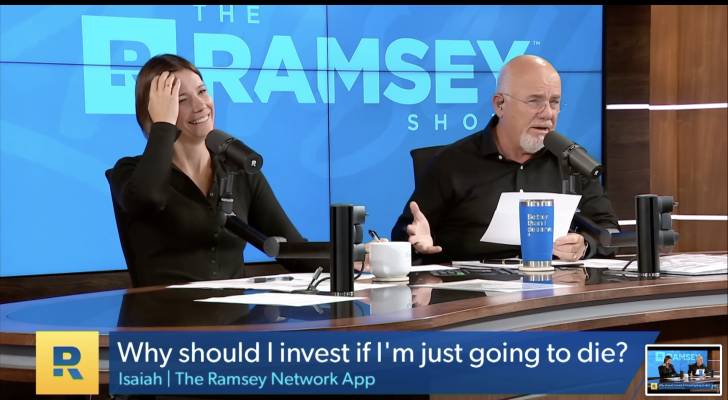‘Fight these goobers’: Washington State man has debt collectors coming after him — but Dave Ramsey thinks negotiating with them should be at the bottom of his to-do list


Jordan from Spokane, Washington, has collection agencies coming after him, so he called into The Ramsey Show for help negotiating with debt collectors. In particular, a repo agent — also known as a repossession agent, who is employed by a collection agency to repossess property over a failure to make contractual payments — has been […]
I’m 68 and retiring in June after 19 years at my company — should I give many months of notice or just 4-to-6 weeks to avoid a last-minute ‘grunt work’ dump?


Mildred has worked as a manufacturing engineer at an auto parts company for the past 19 years. Over time, Mildred has become indispensable to her company. She possesses in-depth knowledge of several of the company’s manufacturing processes that few others have. She loves her job, her coworkers and her manager, but she’s worried about remaining […]
‘You can’t displace someone’: Denver couple taking developers, the city to court over alleged property encroachment — how these types of disputes cause more than just headaches for homeowners
Jorge Cardenas and Griselda Barbosa Martinez from the West Colfax neighborhood of Denver have filed a 50-page lawsuit against the City of Denver, a property developer and a construction company, accusing them of violating the family’s rights and threatening their property, reports CBS News Colorado. The couple claims that, due to the construction next door, […]
If you take CPP at age 60, you will lose 36% of your benefits — but here are 3 key instances when claiming early actually makes a lot of sense. How many apply to you?


For every month you take your Canada Pension Plan retirement benefit early, you permanently lose 0.6%, reducing your monthly cheque up to 36% if you take it at age 60. On the other hand, for every month you wait after age 60, you increase your benefit amount by 0.7%. If you wait until age 70, […]
‘Son, roll up your sleeves’: Dave Ramsey lays into ‘entitled’ man for questioning why to even invest if he might not live to enjoy his riches — but Ramsey says his mindset is the real problem


Sometimes you can get the best advice by poking the bear. One write-in guest on The Ramsey Show found out the hard way after trying to “make sense” of Dave Ramsey’s investment advice. “You keep saying to invest $100 a month beginning at age 30 and you’ll be worth $5 million at 70 years old,” […]
Nearly 25% of Americans are ‘functionally unemployed’ — and that’s a big problem. Are you one of them?


A low unemployment rate typically signals that an economy is generally healthy. The unemployment rate in the U.S. remained near a 50-year-low in April 2025 at 4.2% — plus, American employers added 177,000 jobs in April despite the uncertainty of Trump’s tariffs and trade wars. This all sounds good, right? Not so fast. Don’t miss […]
I’m 68, survived a car crash and have relied on Medicaid for years. Now I’m inheriting $250K from a friend — but fear losing benefits. How can I protect the money, make sure my kids get it?
Imagine this scenario: Two decades ago, Kristin was driving home from a friend’s house when she was struck by a drunk driver, who hit her car head-on. After surviving a coma and suffering a brain injury that made it impossible to work, she’s been on Medicaid ever since. While she has enough money to get […]
Ready to retire with $1,000,000? Here are 3 big risks that can quickly turn your retirement dreams into a nightmare — even with a healthy nest egg. Protect against them now


Many hard-working Americans dream of a retirement with no stress, no daily commute and no demanding boss. Life will surely be better with the freedom to do what you want, when you want… right? Even if you have a decent nest egg of $1 million, there are potential downsides to retirement that you’ll want to […]
‘A lesson in worst practices’: Shocking new audit reveals Chicago parking meters have made $2B for a private company — with 58 years still left in the deal. What everyone can learn from this


Have you ever been strapped for cash? Perhaps you took a payday loan, sold a long-term asset or even made an early withdrawal from your 401(k). And chances are, you’ve later regretted it. This is the situation the City of Chicago finds itself in — and the cost may have been billions. Privatizing public infrastructure […]
Montana farmers — left in limbo as Trump’s ‘random’ tariffs threaten their livelihood — fight back, throwing support behind bill to ‘bring stability and accountability’ to US trade policy


A 25% tariff on Canadian imports has left Montana farmers in limbo and worried about their livelihoods, given Canada is Montana’s largest trading partner. “Many of our farmers, their closest supplier or their closest buyer is from Canada,” Walter Schweitzer, president of Montana Farmers Union (MFU), told NBC Montana. “And they’ve been receiving letters telling […]